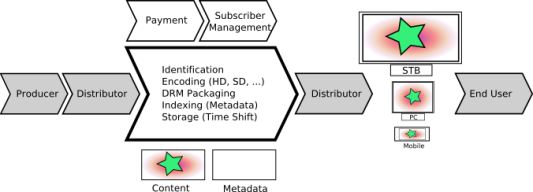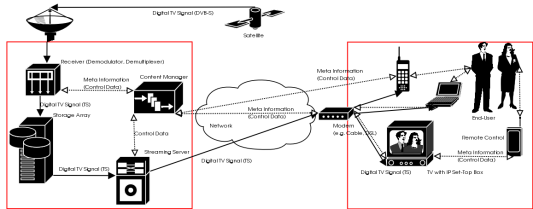Inception
Todays media industry uses DRM not only for preventing illegal
copying but also for bundling services with networks (e.g. TV
channels can be received only on cable networks) or bundling
services with devices (e.g. TV channels can only be received
on certain set-top boxes or mobile devices). By controlling
consumer devices, content providers can exert market power
along the value chain. Innovative media usages like sharing
content amongst different devices or different users are
impossible.
Open standards for interoperable DRM (like e.g. DMP) could eventually lead to a
situation where many independent producers can offer their
content on television - employing business-models and
licensing schemes of their choice. Since such an open market
place contradicts the interests of some of the current major
players, it is a moot point whether interoperable DRM will
succeed in the near future.
Many consumers find that DRM takes away the advantages of
owning content stored on physical media (independence of
location, independence of time, security of continued access,
cost control) while it imposes new constraints (dependence on
delivery systems, no cost control, dependence on devices,
insecurity of continued access, loss of privacy). Still it
seems that - if they want to receive the content of the media
industry - in the very near future consumers will be tied to
non-interoperable DRM systems
Consumer rights
With the proliferation of VCRs in the early 1980ies,
television viewers started to make private copies of
television programming. The US Supreme Court's verdict in the
1984 case between Sony and Universal was that it is legal to
make copies of TV shows on your VCR and view them later, even
fast-forwarding through commercials. Copying over-the-air TV
shows represents "fair use" and not a copyright violation.
Consumer rights organizations and organizations of rights
holders have engaged lawyers in a debate on the question which
actions consumers should be legally allowed to execute on
digital content. Recent copyright amendments indicate that
rights holders have succeeded to introduce DRM into copyright
legislation and criminalize the circumvention of copy
protection measures.
But even though the media industry tends to employ DRM to lock
consumers into particular DRM schemes and particular business
models it looks as if consumers still have the right to
timeshift (record and watch it at a different time) TV and to
watch TV on the devices of their choice (e.g. TV on a mobile
device).
Service
MyVids is an interactive service delivery platform that
enables consumers to receive and watch TV in the form of DRM
protected digital video on the devices of their choice
(e.g. IP set-top boxes, PC, mobile devices with an internet
connection). The MyVids platform provides several TV related
services (such as a Virtual VCR, an electronic programme guide
(EPG), video annotation and search tools) to consumers. The
subscription based business model saves cost on End-User
devices and reduces the risk that users cannot use services on
the devices of their choice, because they are are incompatible
with existing content protection technologies deployed by
broadcasters.
MyVids users can not only watch live broadcasts, but also
control the playback (pause, rewind, fast forward) of the live
feed, up to the current point in time. The "Virtual VCR"
enables the capturing and storing of digital television
programmes on the video server for a later play-back. The
choice of specific channels and programs is controlled by a
scheduling mechanism that is linked to the electronic program
guide (EPG) and is under the control of the consumer. An EPG
on the End-User's device enables the viewer to locate and
specify a program that will be casted in the future for
recording. The video recorder functionality can be implemented
by users allocating "personal" hard disk space on the storage
array of the MyVids video server.
End-User
The End-User can use a range of devices providing an EPG to schedule recordings.- EPG on the Display of the TV with IP Set-Top Box
- EPG on a home computer
- EPG on a mobile phone
Content Manager
The Content Manager is a service that provides the User-Interface of the MyVids service and is responsibe for scheduling and managing the content- user management (database, access, privacy)
- control recording of digital TV programmes (allocation of memory)
- indexing of programmes in the database (segmentation, timecode, generating metadata)
- provide metadata about available and recorded programmes to the End-User
- schedule play-back of programmes
- control streaming server (pause, rewind, fast forward)
Receiver
The Receiver demultiplexes the Digital TV (DVB) signal and stores the corresponding programme streams on the Storage ArrayStorage Array
The Storage Array provides provides memory for storing the Digital TV programmesStreaming Server
The Streaming Server copes with the play-back of the Digital TV programmes over the network to the End-UserValue-chain
The diagram indicates where MyVids adds value in the content distribution value-chain:
Use Case
Silvio is a Formula 1 racing enthusiast. He has subscribed to
a Satellite Pay-TV provider in Italy who has the exclusive
broadcast rights to Formula 1 in Italy. Since the Pay-TV
provider protects his assets by a proprietary conditional
access (CA) system, the programmes can only be received on
specially certified set-top boxes.
Because of his job, Silvio often needs to spend several weeks
abroad. Although he has a Pay-TV subscription for watching the
Formula 1 he can never be sure whether he will find a place to
watch the coverage of the race, let alone listen to the
comments of his favorite Italian anchorman.
MyVids offers the solution. For a monthly subscription fee
MyVids enables Silvio to access his Pay-TV channel using any
broadband Internet connection and his notebook or
videophone. Technically this is possible by transcoding the
high-resolution HDTV programme of the Pay-TV channel into a
DRM protected standard resolution SDTV stream and multicasting
it on the Internet. MyVids also offers personal disk space and
an EPG allwoing Silvio to schedule recordings of his favorite
TV programmes.

